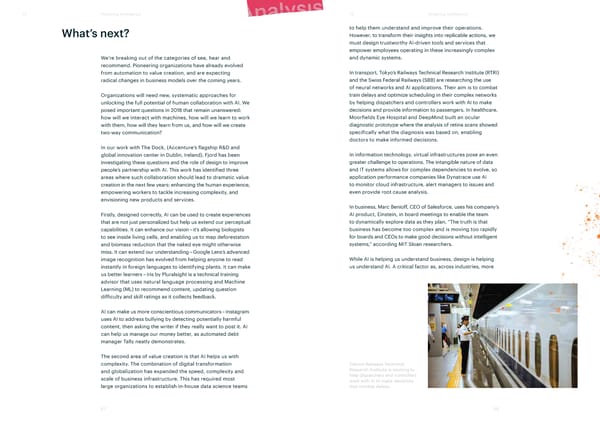T5 Designing intelligence T5 Designing intelligence to help them understand and improve their operations. What’s next? However, to transform their insights into replicable actions, we must design trustworthy AI-driven tools and services that empower employees operating in these increasingly complex We’re breaking out of the categories of see, hear and and dynamic systems. recommend. Pioneering organizations have already evolved from automation to value creation, and are expecting In transport, Tokyo’s Railways Technical Research Institute (RTRI) radical changes in business models over the coming years. and the Swiss Federal Railways (SBB) are researching the use of neural networks and AI applications. Their aim is to combat Organizations will need new, systematic approaches for train delays and optimize scheduling in their complex networks unlocking the full potential of human collaboration with AI. We by helping dispatchers and controllers work with AI to make posed important questions in 2018 that remain unanswered: decisions and provide information to passengers. In healthcare, how will we interact with machines, how will we learn to work Moorfields Eye Hospital and DeepMind built an ocular with them, how will they learn from us, and how will we create diagnostic prototype where the analysis of retina scans showed two-way communication? specifically what the diagnosis was based on, enabling doctors to make informed decisions. In our work with The Dock, (Accenture’s flagship R&D and global innovation center in Dublin, Ireland), Fjord has been In information technology, virtual infrastructures pose an even investigating these questions and the role of design to improve greater challenge to operations. The intangible nature of data people’s partnership with AI. This work has identified three and IT systems allows for complex dependencies to evolve, so areas where such collaboration should lead to dramatic value application performance companies like Dynatrace use AI creation in the next few years: enhancing the human experience, to monitor cloud infrastructure, alert managers to issues and empowering workers to tackle increasing complexity, and even provide root cause analysis. envisioning new products and services. In business, Marc Benioff, CEO of Salesforce, uses his company’s Firstly, designed correctly, AI can be used to create experiences AI product, Einstein, in board meetings to enable the team that are not just personalized but help us extend our perceptual to dynamically explore data as they plan. “The truth is that capabilities. It can enhance our vision – it’s allowing biologists business has become too complex and is moving too rapidly to see inside living cells, and enabling us to map deforestation for boards and CEOs to make good decisions without intelligent and biomass reduction that the naked eye might otherwise systems,” according MIT Sloan researchers. miss. It can extend our understanding – Google Lens’s advanced image recognition has evolved from helping anyone to read While AI is helping us understand business, design is helping instantly in foreign languages to identifying plants. It can make us understand AI. A critical factor as, across industries, more us better learners – Iris by Pluralsight is a technical training advisor that uses natural language processing and Machine Learning (ML) to recommend content, updating question difficulty and skill ratings as it collects feedback. AI can make us more conscientious communicators – Instagram uses AI to address bullying by detecting potentially harmful content, then asking the writer if they really want to post it. AI can help us manage our money better, as automated debt manager Tally neatly demonstrates. The second area of value creation is that AI helps us with complexity. The combination of digital transformation Tokyo’s Railways Technical and globalization has expanded the speed, complexity and Research Institute is working to scale of business infrastructure. This has required most help dispatchers and controllers work with AI to make decisions large organizations to establish in-house data science teams that combat delays. 67 68
 xReport Page 38 Page 40
xReport Page 38 Page 40